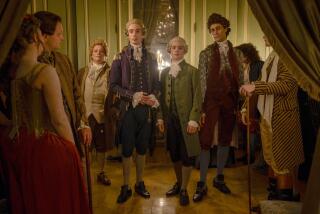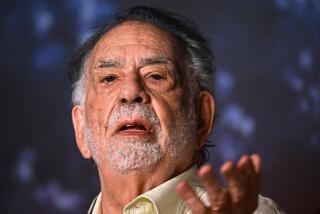‘The Godfather’: A restoration offer they couldn’t refuse
- Share via
Fans who pick up the recently announced “The Godfather: The Coppola Restoration,” due out from Paramount Home Entertainment on DVD and Blu-ray on Sept. 23, are likely to see things in the 1972 Mafia saga and its two sequels they’ve never noticed before. The differences could be subtle to the casual observer, but the improved color and clarity give new visual punch to some of the most cherished sequences in recent cinema history.
“We wanted the blacks to be truly black, and the first image of Bonasera [Salvatore Corsitto] was to appear out of that,” said Francis Ford Coppola, speaking via e-mail about the opening scene of his landmark drama.
The restoration was a sizable undertaking that required a team of technicians, several hundred thousand dollars and two years of effort, largely because the negative for “The Godfather” had been nearly destroyed by overprinting and mishandling.
“I believe that there were only five or six shots in the first 20 minutes that were still original,” said restoration supervisor Robert Harris, who previously had worked to restore films including “Vertigo” and “Lawrence of Arabia.” “Virtually every splice was held together with Mylar tape. Tears went into image in hundreds of frames. Sections were totally without perforations.”
The restoration might never have happened, though, without the intervention of Coppola’s old friend Steven Spielberg. He persuaded Paramount Chairman Brad Grey to greenlight the undertaking, which included full-digital restorations of “The Godfather” and “The Godfather: Part II” and the remastering of “The Godfather: Part III.”
“The restoration took so long because the former Paramount policy was not to spend money,” Coppola said. “I called [Spielberg], knowing how much he believes in restoration and how much he had expressed to me that he loved this film.”
Although Coppola was not directly involved in the restoration effort, he offered Harris several directives in “bringing the [first two] films back to what they were in 1972 and ’74.” Harris, in turn, relied on Gordon Willis, the trilogy’s cinematographer.
Known as the “Prince of Darkness,” Willis typically underexposed light to heighten the mood of a scene and maintained strict control of how the negative was printed.
“ ‘The Godfather’ [films] were designed to have a kind of classic retrospective look,” Willis explained by e-mail from Massachusetts. “The lighting structure came out of a need to present [Marlon] Brando properly as an aging, monolithic don. My choice was to use overhead lighting to enhance Marlon’s makeup.”
The most dramatic enhancement, however, was to “The Godfather’s” pivotal restaurant sequence, in which Michael Corleone (Al Pacino) guns down Sollozzo (Al Lettieri) and Capt. McCluskey (Sterling Hayden). Because of a printing error, half of the sequence always looked faded.
“This was one sequence that we held to the very end of the restoration,” Harris said, “as we had [inspection technician] Joe Caracappa looking through hundreds of [film] cans from which we could attempt to harvest a better image . . . and the sequence finally looks as it should. You can really see the tension on Michael’s face for the first time.”
More to Read
From the Oscars to the Emmys.
Get the Envelope newsletter for exclusive awards season coverage, behind-the-scenes stories from the Envelope podcast and columnist Glenn Whipp’s must-read analysis.
You may occasionally receive promotional content from the Los Angeles Times.










